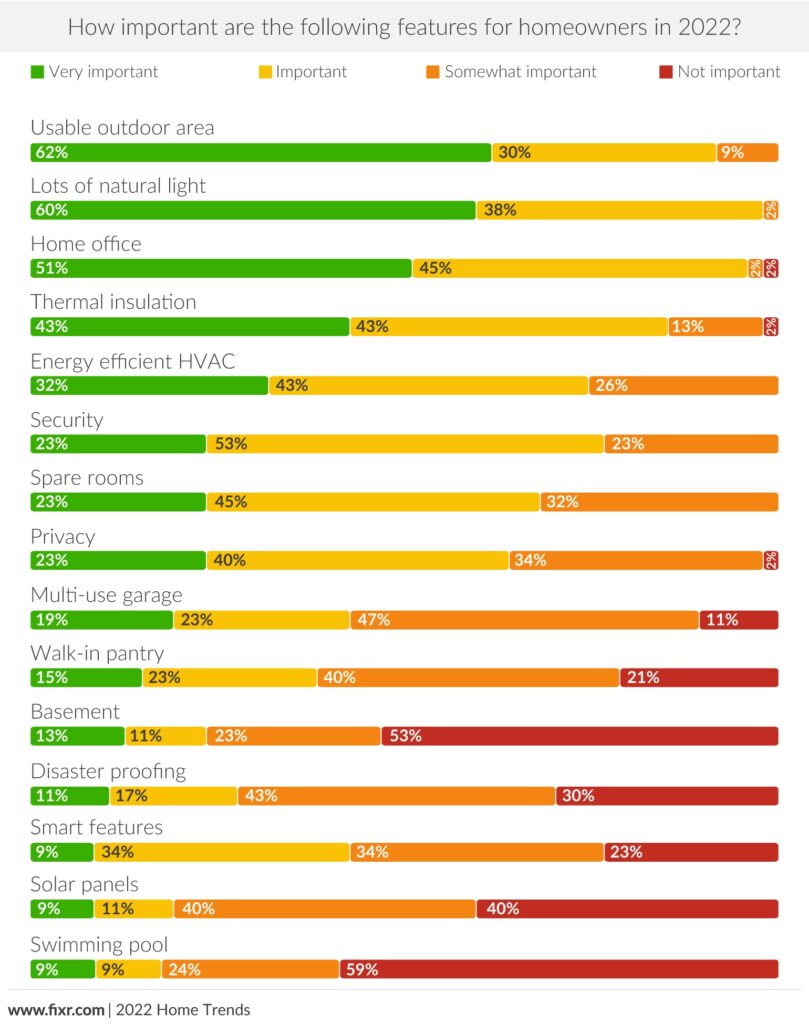Inman News
The pandemic continues to impact homeowner needs, according to Fixr’s 2022 Home Design report. Outdoor spaces and home offices topped owners’ lists while pools sunk to the bottom.
Although most Americans have returned to their pre-pandemic work and social protocols, homeowners are still steadfast in their desire for outdoor spaces, home offices, and other home features that made the earlier days of the pandemic easier to bear.
Forty-seven of the nation’s top home designers told remodeling platform Fixr on Monday that natural lighting (98 percent), home offices (96 percent) and useable outdoor spaces (92 percent) are at the top of their clients’ renovation wish lists.
In comparison, pandemic favorites such as swimming pools (18 percent), solar panels (20 percent) and smart-home features (43 percent) have fallen out of favor, according to Fixr’s 2022 Home Design report.

The thirst for useable living spaces, also known as blended living spaces, started well before the pandemic, with luxury homeowners and homebuyers spending six figures on extended roofs, outdoor kitchens, pergolas and sliding glass walls.
“Agents can help buyers to get over the sticker shock by pointing out the potential to utilize the backyard as a living space,” a HomeAdvisor expert told Inman in 2017 of blended spaces. “This could make a 2,000-square-foot home live a bit like a 2,200 square-foot home. That’s a 10-percent reduction in the price-per-square-foot value ratio.”
Although the value of blended spaces was a hard sell then, home designers told Fixr that homeowners now see the benefit of fully utilizing their backyards.
“By creating a functional outdoor living space, you have more usable areas on your property to enjoy,” the report read. “This can allow you to entertain, relax, or exercise without having to go anywhere, increasing enjoyment in your home.”
Alongside useable outdoor space and natural lighting — which experts said is in tandem with homeowners’ quest for more energy-efficient thermal insulation (86 percent) and HVAC systems (75 percent) — owners are still investing in swanky home offices.
Ninety-six percent of designers said their clients rated home offices as a “very important” or “important” feature, with the average homeowner spending $3,500 to transform their spare room into an enviable work-from-home oasis.
Although Fixr didn’t provide a cost breakdown, real estate agents have been documenting their clients’ office must-haves throughout the pandemic, which reach far beyond a sturdy desk, ergonomic chair, and good wi-fi access.
In 2020, ‘zoom rooms’ skyrocketed in popularity as homebuyers searched for high-aesthetic rooms perfect for virtual meetings. In a previous Inman article, several other agents told Inman their clients invested in green screens, soundproofing, noise-canceling microphones and hi-definition cameras to attract buyers — a move that easily sparked bidding wars in the pandemic’s heyday.
“[The zoom room] was a main selling point, and I think the home will be under contract by tomorrow morning, and I know two of the three buyers who seem strongly interested in it like the option of working from home and having a space away from the family to do conference calls,” one agent told Inman of his ‘zoom room’ success in 2020.
Rounding out the list of homeowners’ must-haves are home security systems (76 percent), spare rooms (68 percent), privacy features including automatic blinds and fences (63 percent), and multi-use garages (42 percent).
Spare rooms are the priciest upgrade of the bunch, with homeowners spending up to $80,000 for adding extra rooms to their abodes. Multi-use garages are slightly cheaper, with the average cost of building a new, suped-up garage landing between $30,000 and $60,000.
“A multi-use garage offers many of the same benefits; you can use space for working, storage, or to convert later into additional living space,” the article read. “Forty-two percent of the experts believe it is either ‘very important’ or ‘important’ for homeowners as having this flexibility means that your home is better able to roll with life and any potential twists in the road ahead.”
Lastly, swimming pools (18 percent), solar panels (20 percent) and smart-home features (43 percent) have slid down to the bottom of homeowners’ necessary home features. Fixr noted climate trends nixed the demand for pools, as droughts place pressure on water supplies.
